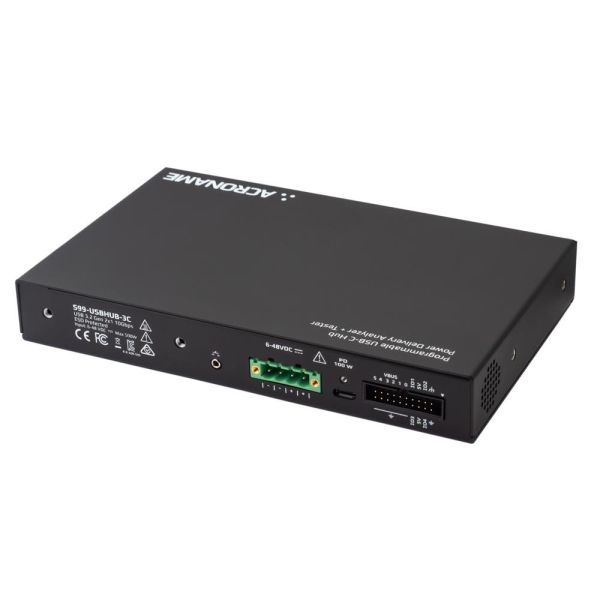The store will not work correctly in the case when cookies are disabled.
USBHub3c: USB-C Hub with Power Delivery Analyzer + Tester | USB 10Gbps (USB 3.2 Gen2x1)
₹155,760.00
(B2B customers can get this product at ₹ 132000 by availing GST input credit)
In stock
SKU
usbhub3c-pd-analyzer-usb10gbps
-
 Delivery is estimated within 25 days of order confirmation.
Delivery is estimated within 25 days of order confirmation.
-
 Price is inclusive of GST and Import duty charges
Price is inclusive of GST and Import duty charges
-
 Buy on EMI starting at 1824/month
Buy on EMI starting at 1824/month
-
 The product is eligible for Free Shipping
The product is eligible for Free Shipping
USBHub3c: USB-C Hub with Power Delivery Analyzer + Tester | USB 10Gbps (USB 3.2 Gen2x1)
- 8 USB-C?? ports
- 6 Individually-controllable dual-data dual-power USB 10Gbps ports (USB-C)
- 1 Dedicated control port (can be controlled from any port)
- 1 Dedicated power input port
- Individually enable Hi-Speed (480Mbps) and SuperSpeed (5Gbps/10Gbps) data lines on each port
- Turn any port on or off via software control without physical interaction
- Flip USB-C connections via software without physical interaction
- Control and monitor via USB: through the dedicated Control Port or the assigned upstream port
- Assign host/upstream or device/downstream role to any port
- Assign power source or sink role to any port
- Support USB-PD modes up to 20V/5A on each port
- Constant Current Limiting on each port
- Supports USB-PD Fixed, Variable, Battery, and Standard Power Range (SPR) sink and source profiles
- Ambient temperature range up to 50?øC
- ESD protected to ?ñ15kV contact discharge (certified to IEC61000-4-2 Level 4)
- DIN rail mountable (Acroname part C56-DINM-1 or C55-DINRA-1)
- Fast Role Swap Support
Enable and Disable Ports
Disable USB Data Lines
Control USB-C Cable Orientation (Cable Flip)
USB Power Delivery Source and Sink (USB-PD Dual Power Role)
USB-PD Power Role Swap
More Information
| specification |
USB-C Port Characteristics
| Parameter |
Conditions/Notes |
Min |
Typ |
Max |
Units |
| Vbus Source Power6 |
Pro Edition |
- |
- |
100 |
W |
| Vbus Source Power6 |
Lab Edition |
- |
- |
15 |
W |
| Output Voltage, Vbus |
Pro Edition |
3.1 |
5.25 |
21.0 |
V |
| Output Voltage, Vbus |
Lab Edition |
4.95 |
5.25 |
5.40 |
V |
| Vbus Measurement Full Scale Range |
|
0 |
- |
32 |
V |
| Vbus Measurement Resolution |
|
- |
488 |
- |
µV |
| Vbus Measurement Accuracy |
|
-0.05 |
- |
0.05 |
% |
| Vbus Ripple Voltage |
Peak to peak at target Vbus voltage |
-15 |
- |
15 |
mV |
| Vbus Short-circuit Trip Current, Ilimit |
|
TBD |
- |
TBD |
A |
| Vbus Short-circuit Trip Time, tlimit |
|
- |
TBD |
- |
µS |
| Vbus Short-circuit Average Current, Ishort |
After trip |
TBD |
TBD |
TBD |
A |
| Vbus Current Measurement Full Scale Range |
|
-10 |
- |
10 |
A |
| Vbus Current Measurement Resolution |
|
- |
300 |
- |
µA |
| Vbus Current Measurement Accuracy |
|
-0.2 |
- |
0.2 |
% |
| Vbus Current Measurement Range |
|
-10 |
- |
10 |
A |
| Vbus Current Limit Trip Point Range |
Software programmable |
-5000 |
- |
5000 |
mA |
| Vbus Current Limit Trip Point Resolution |
|
- |
TBD |
- |
mA |
| Vbus Overcurrent Trip Time trip |
Time from overcurrent at 90%-10% fall time across Vbus values |
0.05 |
1 |
1.5 |
ms |
| USB SuperSpeed Data Rate |
May depend on host or devices |
- |
- |
10 |
Gbps |
| USB Hi-Speed Data Rate |
May depend on host or devices |
- |
- |
480 |
Mbps |
| Vbus Current Supply (SDP mode) |
USB 2.0 data lines disabled or no USB host present, device limited |
- |
100 |
- |
mA |
| Vbus Current Supply (SDP mode) |
USB 2.0 data lines enabled and USB host present, device limited |
- |
500 |
- |
mA |
| Vbus Current Supply (CDP mode) |
USB 2.0 data lines enabled, USB host present, device limited |
- |
1500 |
- |
mA |
| Vbus Current Supply (DCP mode) |
USB 2.0 data lines enabled, no USB host present, device limited |
- |
5000 |
- |
mA |
| Vconn Output Voltage, Vconn |
USB 2.0 data lines enabled, no USB host present, device limited |
4.0 |
5.0 |
5.5 |
V |
| Vconn Output Voltage Ripple |
Peak to Peak |
- |
132 |
- |
mA |
|
 Delivery is estimated within 25 days of order confirmation.
Delivery is estimated within 25 days of order confirmation.
 Price is inclusive of GST and Import duty charges
Price is inclusive of GST and Import duty charges
 Buy on EMI starting at 1824/month
Buy on EMI starting at 1824/month
 The product is eligible for Free Shipping
The product is eligible for Free Shipping




